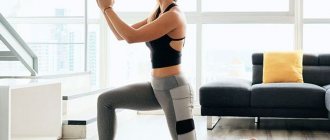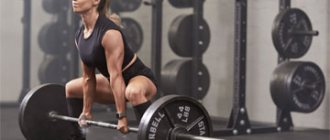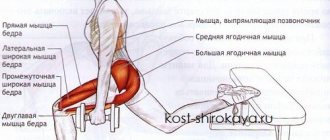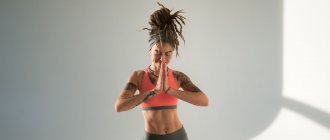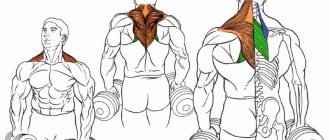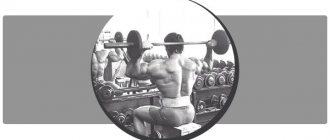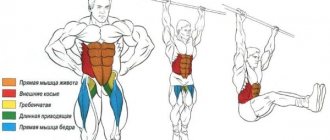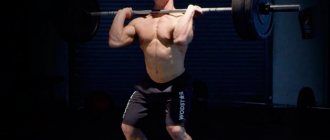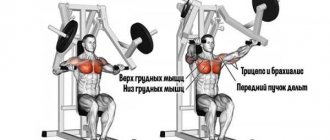Most girls, following modern fitness fashion, strive to get rounded and toned buttocks. One of the best ways to get the shape you want is to perform lunges with dumbbells or a barbell. The exercise is no less effective for men, since it forms the correct shape of the thigh, which cannot always be achieved with squats and leg presses alone. For both, the exercise will be useful if the technique is performed correctly.
What muscles are used by lunges?
When performing lunges, a large number of muscles in the lower body are involved. The degree of impact on the gluteal region surpasses even BAR SQUATS. There are several main muscles:
- Quadriceps . This muscle group is involved in hip extension. Which is basically what we will do in this exercise. Each variation will involve different muscles of this muscle group (there are four in total).
- Gluteus maximus and minimus. This is the desired goal for most girls in the gym. Lunges are one of the best exercises that can develop this area. Thanks to small changes, you can shift the load from the quadriceps to the buttocks. And then they will be even more involved. This will have a phenomenal effect on their development. But we'll talk about this later.
Also, it uses a large number of secondary assistant muscles:
- Biceps femoris . Although this muscle is not involved in movement during lunges, it helps keep us in a stable position. Stabilizes the hips.
- Soleus and gastrocnemius. And these muscles act as stabilizers of the foot. And they work in static voltage.
Abs and spinal extensors.
As always, they provide support for our spine and help us keep our torso in an even position.
Lunges
When we reach a more professional level in training. And we will be able to add additional weights to lunges: dumbbells, barbells, weights, etc. Additionally, the game will include:
- Forearm
- Trapezoid
- Deltas
These muscle groups will help hold the weight we have chosen.
The advantages and benefits of such an exercise as lunges
Advantages
- It is an excellent assistant in building strong and strong legs. It also tightens the buttocks making them rounder.
- By performing lunges, you can count on an increase in the size of the target muscle groups (hips, buttocks).
- Connects a large number of stabilizer muscles. Over time they will grow stronger and stronger. At the same time, we will gain much greater stability, which will help us lift larger weights in basic exercises.
- Makes muscles more elastic.
- In terms of the degree of injury, lunges fall almost to the end of the list of all leg exercises.
- To perform this exercise, you do not need a lot of bulky equipment.
- You can perform it in any place convenient for you: at home, in the gym, on the street.
Flaws
- Since the exercise is performed on each leg in turn, the time spent on it will be spent twice as much.
- If the technique is incorrect, a very large load is placed on the knee joint.
- The technique is a little complicated and requires much more dedication from novice athletes.
Beneficial features
Using different diets and exercises, it is not always possible to form beautiful and firm buttocks. Why? Maybe there are some secrets that we don’t know about?
Fitness trainers know all sorts of tricks and always include, in addition to a variety of exercises, various types of lunges. These simple exercises have many supporters. They are the ones who help you achieve your goal and get excellent results.
They are great for removing “ears on the thighs” and burning fat between the legs.
This exercise helps to work out the muscles of the buttocks, abdomen and thighs. It burns calories perfectly, speeds up metabolism, and promotes the formation of strong muscles. Firm buttocks, slender legs, toned thighs - this is the result you will get by regularly practicing a set of exercises with lunges.
Regularity and persistence are essential components of success. Exercises performed occasionally, as a rule, do not produce any effect.
Lunge options
As for the variability of lunges, there are a lot of them. There are already specially designed programs consisting only of this exercise. Of course, we will not go into their details, but will only look at the most popular options.
Classic lunges in place (static version).
Classic lunges in place
We will perform this option while standing in one place. That is, we take the starting position and do it a given number of times. It looks like this. We put one foot forward and place it on a full foot. And we put the one standing behind on its toe. By performing lunges in this style, we will keep the target muscles in constant tension (static). We can beat them well, and this will have a beneficial effect on muscle growth. This option is best for beginners to start with. Since it will be difficult for them to maintain balance while performing lunges in motion. Also, the classic version is suitable for those whose goal is to build muscle mass.
Forward lunges with alternating legs
Forward lunges
It looks roughly the same as the classic version, only we lunge with each leg in turn and return them to the starting position. This exercise puts a little more stress on the front of the thigh. This happens when the leg returns to its original position. To do this, we will need to take the body a little back. And push off the floor with your supporting leg. With this position of the body, it is more difficult to load the gluteal muscles, since they are in a compressed state. This means they will bear a smaller share of the load. In my opinion, these attacks have several disadvantages:
- The exercise requires a lot of time to complete. Since there is a constant alternation of legs with a return to a standing position. This option will take twice as long to complete. If you don’t have it, then this lunge option is not for you.
- Floating load . When we lunge, for example, with our right leg, we load the gluteal region and thigh of that side. And when returning to its original position, it disappears. And now until we do a repetition on the left side, the right one will not be used.
Of course, there is an opinion that during drying this option is more suitable. Since much more energy is spent on its implementation. This in turn burns more calories.
Lunges with alternating legs backwards (reverse lunges).
But here things are a little different than with forward lunges. We will step back and then return the leg to its original position. The main problem will be that we cannot see where we are placing our feet, so it will be difficult for inexperienced athletes to maintain balance. Unlike the previous option, when returning to the starting position we will have to tilt the body a little forward. This means that the gluteal muscles will stretch more and most of the load will be transferred to them. So if your goal is to develop the buttocks, then it is better to use this option. The disadvantages are the same: it takes more time to complete the exercise and there is no constant load on the muscles. Personally, I have never seen this option performed by men, but girls do it often.
Cross lunges back
This is a more complex variation of the reverse lunge. To perform it, you need a good stretch of the knee and hip joints. This version is reminiscent of the “Curtsey” style greeting. That is, we will not move the back leg in a straight line, but will lead it behind the one in front. Of course, you will have to significantly reduce the weight of the burden. Since there is a very high risk of injuring the knee. All because of their unnatural bending (slightly at an angle). But why do we even need to lunge at an intersection? Of course, in order to further stretch the gluteal region. This will lead to their greater involvement in work. This option is also recommended for the fair sex. But before you pick up dumbbells, you should do some stretching. And also practice the technique in regular lunges with a step back. And only then start performing crossovers.
Passing lunges
This is also a very common option. It is performed with dumbbells or a barbell. I think it’s clear from the title that we will walk around the hall, alternating our legs. And it may seem that everything is basically clear, this is an analogue of lunges with a step forward. But I can assure you these are completely different exercises. When moving around the hall, we will not return to the starting position (step back), but will continue to move forward. This means moving our body forward in the direction of the hips and the gluteal muscles stretching as much as possible. And I already talked about this. The stronger the stretch of the buttocks, the greater the load on them. Of the minuses, I would highlight only one point. If you have a small room in which there is no room to turn around, then you simply cannot do this option. Ideally, you want space at least 5 steps forward and 5 steps back.
Bulgarian lunges
This is another of the famous lunge modifications that girls love to perform. This is because Bulgarian squats work the gluteal muscles very well. This exercise looks like this: First, we need to prepare our inventory. This includes a bench press and, if necessary, weights. Next, take dumbbells in your hands or place a barbell on your shoulders. Place your back leg with your toe on the bench, and put your front leg forward, as in the classic version. Thanks to the fact that the back leg is on a hill, we can better stretch the gluteal muscles. In my opinion, Bulgarian lunges are a little easier to perform than other options. Therefore, if you are a beginner and want to pump up your buttocks, then take a closer look at this exercise. And I seem to have said everything, but I think many of you are wondering why these attacks are called Bulgarian? Of course, judging by the name, it is immediately clear that Bulgaria is involved in the history of their creation. In 1972, the Bulgarian weightlifting team at the Olympic Games in Munich was ahead of all other countries. When in the future the techniques that they used in training were studied. It was precisely these lunges that were identified, which no one had performed in this version even then. That's why they were called Bulgarian.
Lunges with emphasis on the step platform
This is the last of the lunge variations that I would like to mention. Technically it looks like this. We set up a step platform in front of us. We place one of our legs on it and move the other one back. And we do lunges on the spot, changing legs only after we’ve done the given number of times. By performing such lunges, we can stretch the gluteal region more, and also constantly keep the quadriceps in tension. You could say this is an analogue of classic lunges, but aimed at the gluteal region.
Why are they needed?
Lunges on each leg work the hip and knee joints, and also engage muscle groups such as:
- quadriceps femoris;
- gluteal;
- dorsal;
- press;
- soleus;
- calf;
- synergists;
- shins.
Trainers often recommend that beginners and experienced athletes include this exercise in their training, and all because:
- loads the gluteal muscle and the front of the thigh to the maximum;
- much more effective than squats and deadlifts;
- strengthens the stabilizer muscles of the trunk and pelvis;
- improves the sense of balance;
- completely safe for the knees, even if the execution technique is not followed;
- it is recommended to use, but without burden, even during the rehabilitation period after surgery or injury;
- has a lot of variations, helps to shift the emphasis of different groups, and at the same time pumps up the core and upper body.
Execution technique
Initial position:
- Stand straight with your feet together. If you are not a beginner, then pick up dumbbells or put a barbell on your shoulders (This also includes a Smith machine).
- Take a step forward with either foot, placing it flat on the floor or on the step platform. And stand on your toes with your back. In Bulgarian lunges, our back leg will lie on the bench. During reverse lunges we will step backwards. The stride should not be too short or long. Your main task is to ensure that when bending, the front and back legs create a 90° angle at the knee. To make the position more stable, turn your front foot slightly inward.
- When performing an exercise with your own weight, keep your arms at your sides or in front of you. If you take dumbbells, then lower your arms down to your sides and turn your hands inward. When performing with a barbell or in a Smith machine, the bar is placed on the top of the trapezius. And with our hands we hold it from below, slightly wider than shoulder-width apart.
- The gaze is directed forward, the back is straight, there is a slight deflection in the lower back.
Performance:
- From a standing position with your feet together, take a step forward or backward.
- As you inhale, bend your front leg so that your knee does not extend beyond your toes.
- Hold this position for a few seconds for maximum stretching of the working muscles. And with an effort as you exhale, push your body up.
- If you are performing reverse lunges, step forward or walk through. Then return your legs to the starting position, and then do the same with the other one.
Training programs
Both men and girls often include lunges with dumbbells in their complexes.
Most popular programs:
| Women's Leg Day. Emphasis on the back of the thigh and glutes | |
| Exercise | Sets x reps |
| Romanian barbell deadlift | 4x12 |
| Lunges with dumbbells with an emphasis on the hamstrings | 4x10 (for each leg) |
| Smith squats with emphasis on the hamstrings and glutes | 4x12 |
| Seated leg curls | 3x15 |
| Standing single leg curls | 3x15 |
| Glute bridge with barbell | 4x12 |
| Women's Leg Day | |
| Exercise | Sets x reps |
| Barbell Squats at Smith | 4x15 |
| Lunges with dumbbells | 4x10 (each leg) |
| Leg press in the simulator | 3x12 |
| Plie squats with dumbbells | 3x12 |
| Glute bridge with barbell | 4x12 |
| Superset of leg extensions and flexions in exercise machines | 3x12+12 |
| Men's Leg Day | |
| Exercise | Sets x reps |
| Squats | 4х12,10,8,6 |
| Romanian deadlift | 4x10 |
| Leg press in the simulator | 3x12 |
| Walking lunges with dumbbells | 3x10 (each leg) |
| Leg extensions in the simulator | 3x15 |
| Leg curls in a lying machine | 3x15 |
Recipes for healthy eating
Uzbek pilaf on fire in a cauldron
- 7.9 g Protein
- 17.1 g Fat
- 24.9 g Carbohydrates
- 232 kcal
60-80 min.
- #mutton
- #barberry
- #second course
- #jeera
- #turmeric
- #carrot
- #dinner
- #paprika
- #chilli
- #pilaf
- #vegetable oil
- #onion
- #rice
- #dinner
- #garlic
Other recipes
Recommendations for implementation
- To make your stance more rigid, experiment with the width of your feet. You can also turn the foot of the front leg slightly inward.
- The wider you place your feet, the more the gluteal muscles are activated. Accordingly, with a narrower setting, the quadriceps is included.
- If you want to increase the load on the gluteal muscles, then tilt your body slightly forward towards the hip. This way you will stretch this area more at the bottom point.
- Without swaying from side to side. This way you will perform the exercise by inertia and will not be able to fully engage the target muscles.
- Do some stretching at the end of every leg workout. This will make your muscles and joints more elastic.
Mistakes when performing lunges
When performing any exercise, you should not make mistakes. Of course, not all people know about them, so they cannot identify them immediately. Here are the main ones when performing lunges:
- The knee extends beyond the toe or inward. May cause injury to the knee joint. So keep an eye on it during execution.
- Round back. This exercise puts more stress on the lower back. And it could hurt her. Especially when working with weights.
- Acute angle in the knee joint. That is, when your legs do not form a 90° angle when bent. This will put stress on the knee joint and can lead to injury.
- Legs too wide. We must understand that we are doing lunges, and not trying to do the splits. Therefore, you should not spread your legs too wide.
- The gaze is directed incorrectly. Don't look at your feet. So we will begin to round the back by inertia, and I already spoke about this above.
That's basically all you need to know in order to perform lunges correctly and not injure yourself. Try all the options and decide which one suits you best and adopt it.
Good luck to everyone in your training!
When to expect the effect
To remove extra pounds and get maximum results, you need to adhere to a standard training schedule - 3 times a week. The first results with such a program can be obtained already in the middle of the first month of training. You shouldn’t overdo it, if you don’t give your body rest, it won’t have time to recover and training will bring fatigue and laziness. In order for the abs to be sculpted, in this case you will have to train at least 4 times a week, while you need to work with weights and add as many crunches as possible. Add more lunges and squats to your workout.
The speed of muscle mass gain depends on individual characteristics: the level of training, the absence of bad habits, proper nutrition, and compliance with the training regimen are important. Lunges are a unique exercise that allows you to create ideal legs in women and is also suitable for men to improve body contour. The exercise can be performed on each leg with twisting, weighting, and jumping. This basic exercise is ideal for training at home or in the gym.
